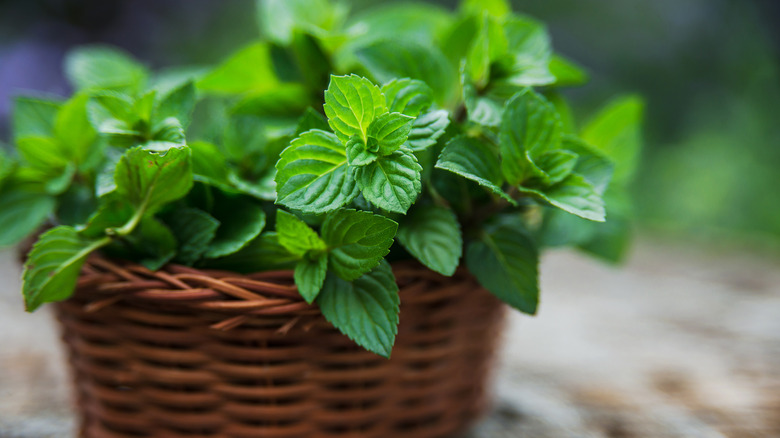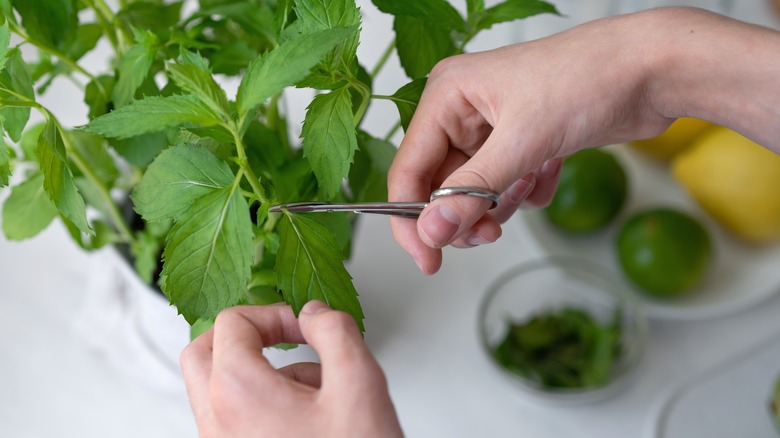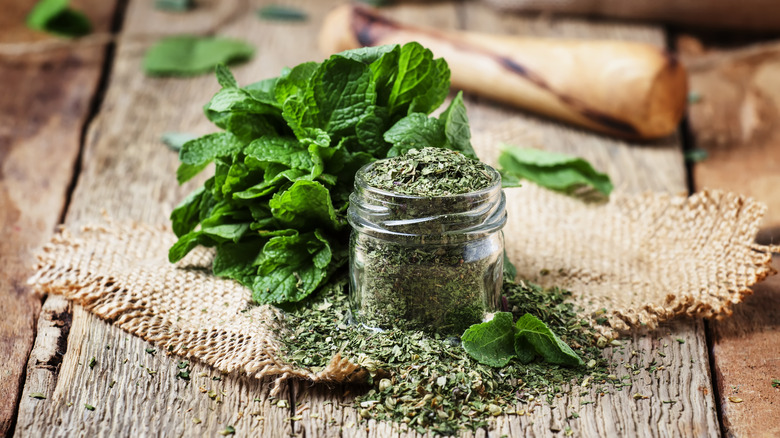The Best Way To Harvest And Store Mint
Mint is an extremely popular herb to grow at home, since it is a low-maintenance plant that can flourish just as well in little indoor pots as it can in sprawling gardens. However, harvesting it and keeping it fresh isn't exactly self-explanatory. The key to making the most of homegrown mint is to harvest it properly, and to avoid mistakes that everyone makes when storing herbs.
One way to harvest mint is to pluck individual leaves with your hands and use them straight away — think blanched mint syrup or a simple mojito recipe. However, plucking can damage the plant, and pulling out leaves haphazardly can also expose the the sprigs to diseases. A much better way to harvest the herb is to cut off entire sprigs of leaves, especially if you plan on storing mint for later use. Not only will these cuts heal much better, but they will also keep the plant healthy and promote the growth of new leaves.
You'll want to clip mint sprigs at the right spot, too. Snip a few inches above the soil line, leaving a lower set or two of leaves alone. This ensures that your plant continues to sprout new mint, even after large harvests. It's also best to use gardening shears or scissors to make clean cuts, rather than pull the sprigs with your fingers.
What to know about harvesting mint
There are a few things to keep in mind when harvesting mint. For one, it's important to identify which leaves are ready for picking and the best time to harvest them. Mint leaves are most flavorful right before they flower, so it's best to choose sprigs with buds rather then letting them bloom. The essential oils present inside the herb lessen once the flowers bloom, which can change the taste for the worse.
It's also a good idea to pick young and small leaves first, rather than larger, more mature ones, as younger ones have the best flavor. You'll find these tender leaves at the top of the plant, typically on the first 10 or 20 centimeters of the stems. Additionally, consider harvesting mint early in the morning — this is when the herb's cool sweetness is most potent.
Harvest mint regularly to encourage it to grow more leaves. However, there is a fine line between "frequent" and "too often," and you'll want to be careful to not over-harvest it. Generally speaking, make sure that you never pluck more than two-thirds of the entire plant in one go, as doing so can weaken it in the long run.
Ways to store fresh mint leaves
Once you've harvested mint, the easiest way to preserve the herb is the same method that you would use to store fresh rosemary in a jar of water. You essentially store the mint like cut flowers, pruning the bottom of the sprigs and standing them up in a half-filled jar. Change the water if it turns cloudy, and use the herb within a week. Make sure that you don't rinse the leaves in advance, as doing so can rob the mint of its essential oils.
If you'd like to keep the mint fresh for another week or two, cover the jar with a plastic bag and place it in the refrigerator. However, it's still best to use it up within a week. Though it may not rot if stored for longer, you'll find that the herb's flavor and aroma deteriorates over time.
If you've plucked off individual leaves rather than stems, wrap them in a damp towel and put them in a perforated zip-top bag. You could freeze mint, if you'd like to extend its lifespan to six months, but it will be soggy when defrosted. An alternative is drying it; you can even use the herb in powdered form in drinks like tea. Bake, air-dry, microwave, or dehydrate the leaves until they are crisp, and optionally blitz them in a food processor. Store the dried mint in a dark and dry place, and use it up within a year.



